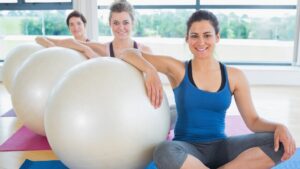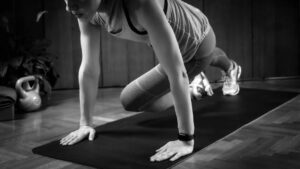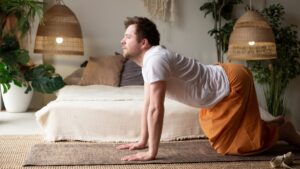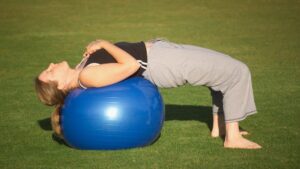1. Improve Your Balance with Tandem Walking
HOW: Tandem walking is like the sobriety test called ‘walk and turn’ used by police officers. Start by placing one foot’s heel directly in front of and touching the toes of the other foot. Walk in a straight line, heel to toe, as if you’re on a tightrope, for 20 steps. Keep your eyes looking forward without looking down at your feet. To make it more challenging, you can try walking backward in tandem.
WHY: As we get older, our sense of balance tends to decline, making us more prone to falls and injuries like head trauma or hip fractures. Doing balance exercises regularly, such as tandem walking or the tree pose in yoga (in a safe manner), can enhance your concentration, coordination, and balance. This is important for everyone, not just older adults, to maintain mobility and prevent falls, as highlighted by Erik Groessl, a professor of public health at the University of California, San Diego.
2. For Stronger Bones, Give the Sit-to-Stand Move a Try
HOW: Find a sturdy chair that won’t slide and sit up straight in it. Keep your feet shoulder-width apart and move to the front edge of the chair. Position your feet so that your heels are slightly behind your knees. Lean forward from your hips, keeping your back straight, and place your hands on your thighs. Push through both legs to stand up, distributing your weight evenly. Sit back down by bending at the hips and lowering yourself with control. Keep your chest lifted throughout the exercise. Repeat this sequence 10 times. To make it more challenging, you can cross your arms over your chest, use a lower chair, or hold lightweight objects in your hands while performing the exercise.
WHY: This type of exercise, known as resistance training, strengthens both muscles and bones. “When you contract your muscles, you exert force on the bones, which promotes bone growth. That’s why resistance exercises are especially beneficial for bone health and for preventing or managing osteoporosis,” explains Lindsay Duncan, a professor of kinesiology at McGill University.
3. Boost Your Brain Health with Interval Walking
HOW: Begin by walking at a moderate pace for five minutes. Then, increase your speed to a brisk walk for two minutes. Repeat this pattern, alternating between longer periods of relaxed walking and shorter bursts of brisk walking, until you have completed a total of 30 minutes. You have the flexibility to decide how much you want to intensify your pace during the shorter intervals and for how long. Interval walking allows you to incorporate higher-intensity aerobic exercise into your routine at your own comfortable speed. You can start gradually by including just one or two short segments of brisk walking within the 30-minute duration. As you progress, you can add more or longer segments of fast-paced walking, or even try jogging.
WHY: According to a study conducted by McMaster University, inactive older adults who engaged in interval walks experienced significant improvements in their memory. Additionally, in studies involving animals, aerobic exercise has been shown to create new blood vessels, which helps neurons thrive even in challenging conditions. Teresa Liu-Ambrose, a professor in the Department of Physical Therapy at the University of British Columbia, explains that brain growth resulting from exercise can lead to enhanced memory, executive function, decision-making, and more. Liu-Ambrose’s research has demonstrated that aerobic exercise reduces cognitive decline in older women and men who have experienced mini-strokes.
4. Maintain Your Muscle Mass with Kneeling Push-Ups
HOW: Get down on the floor with your hands and knees positioned shoulder-width apart. Your knees should be about hip-width apart. Keep your back as straight as possible and align your head with your spine. Take a deep breath as you slowly lower your elbows, bringing your chest closer to the floor while keeping your core muscles engaged. Exhale as you push yourself back up to the starting position. Begin with three or five repetitions and gradually increase the number over time. Aim to reach two sets of 10 repetitions as you progress.
WHY: As we age, muscle mass starts to decline, decreasing by about one to two percent per year after the age of 35. This muscle loss accelerates to three percent per year after reaching 60 years old.
A Danish study conducted in 2022 discovered that older men who engaged in regular physical activity and resistance exercises were shielded against the decline of muscle mass associated with aging. These individuals had more muscle stem cells, which are vital for muscle regeneration and growth, and outperformed both younger and sedentary older adults on muscle-function tests. This study, along with others, has shown that performing 20 to 30 minutes of resistance training, two to three days consecutively each week, can increase muscle mass in adults of all ages. Participants in the study experienced lean-weight gains of approximately 1.4 kilograms after three months.
5. Improve Metabolic Syndrome by Climbing Stairs
HOW: Begin by taking it slow and easy on the stairs, walking up one step at a time until you reach the top. Take your time while walking down and take a brief break at the bottom before starting again. Maintain proper posture and wear supportive running shoes with good cushioning. Control your breathing by inhaling and exhaling slowly, counting to three each time. Breathe through your nose and let your belly expand, avoiding shallow chest breathing. As your fitness level improves, gradually increase the intensity and duration of your stair-climbing sessions. If you have heart disease, respiratory disease, or joint problems, it’s important to consult with your doctor before starting.
WHY: Stair climbing is an effective and low-impact cardio workout that engages more muscles compared to walking on a flat surface. According to a 2021 British study, stair climbing is linked to improvements in blood lipids (cholesterol and triglycerides), abdominal weight, blood pressure, and blood sugar—the four main risk factors associated with metabolic syndrome. Metabolic syndrome increases the risk of developing type 2 diabetes, heart disease, and stroke. Additionally, stair climbing strengthens the muscles and joints of the legs and enhances balance. One reason why stair climbing is beneficial in lowering blood sugar levels is because it targets major muscle groups such as the quadriceps, hamstrings, calves, and glutes. Jenna Gillen, a kinesiology professor at the University of Toronto, explains that when we exercise, our muscles require energy, and one source of energy is sugar from the bloodstream. By exercising larger muscle groups, more of that sugar is used up. Gillen’s study, published in the Journal of Applied Physiology, demonstrated that brief exercise “snacks” lasting less than three minutes every half-hour increased insulin sensitivity in inactive individuals who were otherwise healthy. Improved insulin sensitivity allows the body’s cells to utilize glucose more effectively.
6. Build a Stronger Core with Modified Flutter Kicks
HOW: Lie on your back and place your arms at your sides with your palms facing down. Extend your legs straight up towards the sky, with your heels pointing upward. Slowly lower one heel towards the floor while keeping that leg straight. Lower it as far as you can without lifting your back off the floor. If your back arches as you lower your leg, you’ve gone too far. With control, bring your leg back up to the starting position. Then, switch to the other leg. If you find it difficult, you can make it easier by bending your knees. Aim for five movements on each side, totaling to 10 movements in total.
WHY: Strengthening your core muscles can have several benefits, including improved posture, balance, and stability. It can also help relieve strain on your back and reduce back pain. Strong core muscles make it easier to perform various physical activities like swinging a golf club or tennis racket, doing household chores that involve bending, lifting, and twisting, reaching for items on high shelves, or sitting at a desk or workstation for extended periods.
7. Relieve Lower Back Pain with the Cat-Cow Pose
HOW: Start by getting on all fours, with your hands under your shoulders and knees under your hips. Keep your spine long and neutral. Engage your abdominal muscles and take a deep breath, allowing your belly to expand. As you exhale, round your spine like a cat, tucking your tailbone down. Let your head drop and keep your neck relaxed. Inhale again and transition into the cow pose by arching your back, lowering your belly towards the floor, lifting your tailbone, and bringing your chest forward. Look forward or slightly upward, without straining your neck. Flow between the cat and cow poses for at least 10 rounds, inhaling during the cow pose and exhaling during the cat pose.
WHY: While no single exercise can completely alleviate back pain, the cat-cow pose may provide relief for some individuals. Yoga exercises, like this one, help stretch and strengthen muscles in the abdominal area, obliques, hip extensors, and hip flexors. The movements also promote blood circulation to the spinal discs. A study published in the American Journal of Preventive Medicine in 2017 found that participants with low back pain who participated in a 12-week yoga program experienced less pain and improved quality of life compared to those who received standard care, such as medication, physical therapy, and exercise.
According to Susan Tupper of the Saskatchewan Health Authority, the cat-cow pose is a beneficial warm-up exercise that targets the deep small muscles around the spine, contributing to back pain relief. Additionally, the deep breathing techniques employed in yoga help relax the nervous system. Yoga has also been shown to enhance mood, reduce stress, and alleviate the psychological aspects associated with pain.
8. Improve Flexibility with Neck Rotations
HOW: When performing neck rotations, make sure your shoulders and hips are facing forward. Begin by slowly turning your neck to the right and look over your shoulder. If you want to deepen the stretch, gently bring your chin closer to your shoulder. Hold this position for up to 30 seconds, then switch sides and repeat the movement a few times.
WHY: Neck tilts and rotations are essential exercises that are often included in warm-up routines. Like all stretching exercises, their goal is to enhance flexibility and increase the range of motion in your neck. Some forms of exercise are more effective than others for addressing specific issues. According to a study published in The Journal of Pain in 2016, tai chi was found to be equally effective as neck exercises for treating chronic neck pain. Dr. Patricia Huston, an adjunct professor at the University of Ottawa’s faculty of medicine, emphasizes that tai chi helps establish proper alignment and promotes relaxation, enabling better stretching. For neck rotations, you should aim to keep your head floating and bring your shoulders down, which aligns your body. By gently turning your head from side to side, you can relax the muscles in your neck and alleviate tension commonly experienced by people who spend prolonged periods sitting at a computer.
9. Promote a Healthy Spine with the Rolling Like a Ball Exercise
HOW: Sit on a yoga mat with your legs bent, toes pointed, and knees pulled in towards your chest. Place your hands over your shins, just above your ankles. Relax your shoulders, widen your back, engage your abdominal muscles, and curve your spine into a C shape without tucking your chin. Lift your feet off the mat and balance on your sitting bones. Take a deep breath in as you roll backward towards your shoulders (not all the way to your neck), and exhale as you immediately roll back up. Pause briefly at the top, then repeat the movement. Start with six repetitions.
WHY: This classic Pilates exercise provides stimulation and massage to the spine, which can help alleviate tension. It strengthens the abdominal muscles while promoting the health and flexibility of your spine. According to a 2017 study conducted in Spain, an eight-week Pilates program has been found to be effective in improving disability, pain, flexibility, and balance in individuals suffering from chronic low-back pain.
10. Find Relief from Arthritis with Finger Bends
HOW: Extend your left arm straight out with your palm facing upward and all fingers straight. Slowly bend your thumb towards your palm, hold the position for a few seconds, and then straighten it. Repeat this process for each finger on your left hand, bending and moving them towards the center of your palm, holding, and then straightening. Repeat the entire sequence with your right hand.
WHY: Osteoarthritis can cause pain, stiffness, swelling, tenderness, and weakness in the joints of your hands or fingers. Performing hand exercises, such as finger bends, finger lifts, finger slides, and making hand shapes like a C, O, or fist, as well as wrist bends, can provide relief from these symptoms. These exercises strengthen the muscles that support your hands, making everyday hand movements more comfortable. They also promote the production of synovial fluid, which protects and lubricates your joints. A 2014 study from Norway found that women with arthritis who regularly performed hand exercises experienced reduced hand-joint pain, improved grip strength, and enhanced hand function. Although it may seem counterintuitive for individuals with stiff and painful joints, engaging in exercise for your entire body is crucial for improving daily functioning. Physical activity strengthens the muscles and tissues surrounding the joints, providing crucial support and reducing stress on the bones. Additionally, it helps strengthen bones and combat fatigue. Different types of exercise offer various benefits: range-of-motion exercises reduce stiffness and enhance your ability to move with less or no pain, while resistance exercises build stronger muscles to support and protect your joints. It’s important to consider low-impact exercises, such as walking, cycling, or swimming, as they are gentler on the joints.










